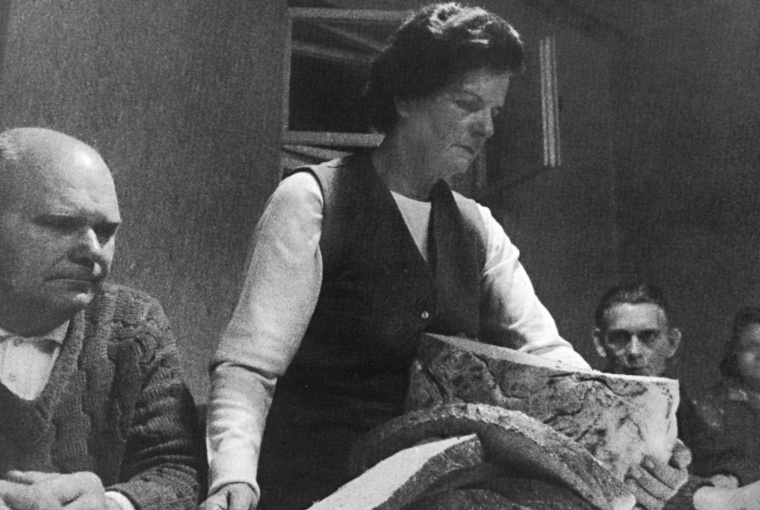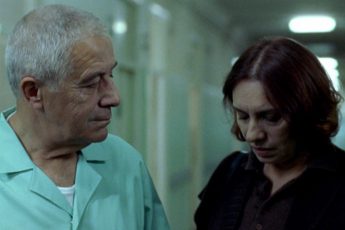
Wojciech Wiszniewski once said that all he could influence as a documentary filmmaker was his work’s form, not its content, which consisted of “objective facts” – form was what allowed him to arrive at credos, what made him who he was. While the obstinate form of Wiszniewski’s films certainly set him apart from many of his fellow filmmakers, its overwhelming importance – his formalism – is simultaneously what connects him to the Polish documentarians of 1970s who sought to free themselves of their predecessors’ minimalism. Through technical advances, filmmakers had taken to the streets in the 1960s: documentaries from Poland started to be in direct contact with the outside world, capturing real lives. Only that the role of the documentarian quickly became secondary: he was relegated to the role of mobile witness and expected to follow rather than lead (even if many films, mainly propagandistic ones, did not closely obey this theoretical mantra). A decade later, the idea of the documentarian as passive observer was definitively capped. Now, it was held that the filmmaker was to capture a world he was himself differentiating, influencing, creating. Whether this reflects those filmmakers’ philosophical views about observation always enclosing participation is unclear1. What is clear is that this methodological innovation clearly contradicts Wiszniewski’s self-portrayal quoted above: while it is perfectly consistent to be a formalist and simultaneously manipulate the very content one is exposing, that challenges the idea that facts, however objective they really are, can be exposed by such films objectively or in an unaltered fashion. Thus, Wiszniewski is a formalist, though one who consciously changes the content he is presenting – in short, both content and form are unique to his approach and far from converging the kind of exaggerated objectivity that his tautological talk of “objective facts” is supposed to summon. That such features are really true of Wiszniewski and why I subsume them under “good formalism”, is something I will try to exhibit in this article.
It will be helpful to retrace Wiszniewski’s filmmaking career more or less chronologically, since his work becomes less conceptual over time and thus increasingly surreptitious with regard to its shrewdly synthetic handling of content and form. Since Wiszniewski died in 1981 at the age of 34, this is not an a priori impossible challenge, though my article will only sketch out the main features of Wiszniewski’s approach, leaving the detailed exegeses to those academics professionally engaged with Polish documentary cinema2. Our journey begins in 1967 with an experimental film school short entitled Heart Attack (Zawał serca), at the end of which the nameless, wordless protagonist of the film is overcome by just that. A title card then reads that according to UNESCO statistics, “a quarter of the population in the whole world dies of heart disease”. The exercise opens inconspicuously with a shot-reverse-shot of protagonist and calculator: the man dials a sequence on the machine, and watches apathetically as numbers start racing up and down. Next, he drives off from work, with the sounds of the machine still audible in the background; he is sweaty, tired, and the shots start adding up to an enervating atmosphere, first through cuts between the car and surrounding shops and windows (which get more frequent and diverse over time), then through distorted visual effects which disrupt the film’s hitherto realistic air. But after 100 seconds, the formalistic build-up is joined by a rebellion of content: at a juncture, our protagonist spots an unconscious man (or several?) pressed against the windshield of his car. We drive on, and for a short moment, everything is back to normal – only the clicking has been replaced by grand jazz music. But soon, the disruptive camera work is back, followed by the next narrative anomaly: on a side street, the protagonist meets a little boy in a skirt skipping rope. He turns the sunblind down, blanking off the child’s head and torso, and finds everything to be in order. Another perspective which conceals the head of the child, and again everything is ok. He drives off. The film now gains speed: we are on a country road, with apparently nothing there to stop the car. But though the streets are clear, our protagonist is distracted – first by romantic impulses (resourcefully insinuated through a magazine), then by his urge to smoke, and finally by his ill-feeling. Whether the hectic atmosphere pervading the film is there to causally explain the fatal ending, or whether Wiszniewski is simply trying to make an anti-climactic plot cinematic, is not entirely clear. At any rate, the ingenious short reveals how Wiszniewski’s evident formalism is sided by a proclivity for orchestration, foreshadowing the kind of approach Wiszniewski would pursue throughout his career.
 Heart Attack (1967)
Heart Attack (1967)
Trace (Ślad, 1969) is next – another film school short -, and again it first seems that formalism can account for the film’s idiosyncrasy. It opens with a shot of a group of railway workers posing for a picture under a sign that congratulates “Comrade Pietrakiewicz” (for his successful career?), wishing him luck and sweets (i.e. candy) for his retirement. After a few seconds, they rise and congratulate him in person. Next, Pietrakiewicz is seen wandering around in a frail courtyard, entering a building. Cut, and he sits at the window in his apartment, reading a newspaper. Like in Heart Attack, the initially innocent juxtaposition intensifies over time, becoming both speedier and increasingly disparate. After Wiszniewski interposes a short flashback of Pietrakiewicz on a normal workday, he is again seen wondering around off duty, this time in the city, lurking in window shops and a car. He is visibly restless. The subsequent cut to his workplace raises our suspicion for the first time: his co-workers march around the railway garage with the sign congratulating Pietrakiewicz. They celebrate him, gathering around and throwing him in the air. Is Pietrakiewicz dreaming, or remembering? The next scene from his post-retirement life signals that Pietrakiewicz searches for the mechanical dynamics of his ex-work place even now, as he stares at various attractions at an amusement park. The short continues in similar fashion, resorting to both formal and non-formal techniques of contrast, juxtaposing movement with immobility, occupation with idleness, emotionalism with apathy. The last shot sees him walking the premises of the railway garage in his plain clothes. Content and form have finally merged at the juncture of reality and phantasy – with the help of seemingly simple techniques, Wiszniewski succeeds in showing how a man’s life is tied to his employment.
Wiszniewski’s next film, Tomorrow. 31st of April, 1st of May 1970 (Jutro. 31 kwietnia – 1 maja 1970), is one of his strongest. Most of it takes place on the day preceding the international worker’s day (though the nominal date – the “31st of April” – is of course fictional), when the protagonist and his friends – young, burly blokes – talk stealing, women, drinking and drugs. After an early beer in the neighborhood, the protagonist proclaims in a voice-over that he is proud of his working class background. Just as he starts explaining how his parents fought for what they have, the young men are seen picking a fight on the street – an ironic meta-commentary with which Wiszniewski immediately discredits all Socialist ideals. Another notable scene features the men silently watching a propagandistic documentary about European and American hippies pilgrimaging to Nepal. The narrator emphasizes that the hippies have no beliefs or ideology, how their creed is to negate everything – all social, moral and political norms. Though the men’s faces are expressionless, one need not conjecture that this description sounds idyllic to them. After all, they go on to a party, where they drink, smoke and fight. The last minute is reserved to the parade, though Wiszniewski again annihilates its propagandistic potential by parallelizing it with an off-key monologue of his protagonist, who speaks about his future plans: he wants a car, a villa, a beautiful girl, and enough money not to work. The last shot shows the crowd marching with signs hailing socialism – an alibi at best.
Tomorrow. 31st of April, 1st of May 1970 is perhaps Wiszniewski’s first film where form and content can no longer be readily distinguished. Indeed, his polemic instruments become mostly formalistic: by contrasting Socialist ideals with the dreams and hobbies of ordinary people, he points to a contrast which no longer builds on a manipulation of either extreme. If one sets aside the fact that Wiszniewski often co-wrote or altogether invented the monologues of his protagonists, that he frequently nudged them to do things they would not have otherwise done, it seems that we have finally arrived at a prime example for a film where the documentarian Wiszniewski asserts himself through how he reveals, not by way of what he reveals. At last Wiszniewski’s self-portrayal appears to be accurate! But on second thought, it becomes clear that this cannot be the case. Would the naïve, propagandistic films of the time show the very same material that Wiszniewski uses, only in a different light? Would they simply polemize those scenes Wiszniewski finds authentic, and idolize those that he polemizes? No. What sets him aside from the party line is not just an ironic handling of propagandistic material, but likewise an incorporation of fates, perspectives and situations that were actively concealed by the regime. That Wiszniewski superimposes the 1st of May parade with our protagonist’s dreams of partying and material goods is just the tip of the iceberg. Pro-party films would not dwell on young people’s material and carnal priorities at all. They would instead depict those individuals who strove for perfection in work and education. What is wrong with Wiszniewski from the regime’s perspective is not just his vocabulary, but the very topics he addresses. And that transcends form.
In my opinion, Wiszniewski was perfectly aware of this – the fact that he described himself as a radical formalist can be read as an attempt to fend off political counter-measures (if a modestly successful one, as virtually all of his films were banned from circulation). In truth, his films constantly remind us that there is no such thing as an objective perspective. Take The Story Of A Man Who Worked 552% Above His Quota (Opowieść o człowieku, który wykonał 552% normy, 1973), in which Wiszniewski portrays model worker Bernard Bugdol, whose efficiency allowed him to break records – allegedly that is, for Wiszniewski soon deconstructs the very myth he set out to reconstruct by interviewing people who doubt the official version. Was he helped, were the quotas different, or are people just jealous? Various misgivings are voiced without a definitive outcome, but perhaps a definitive outcome is not what Wiszniewski is after: his message seems to be that even the official version is not a given, that people doubt it and moreover have good reasons to do so. Later, Bugdol is interviewed face-to-face, forcefully parrying critical questions which question the legitimacy of his activities. His answers are well-weighted and were conceivably prepared, but the point again seems to be that no narrative is immune to doubt. More than that, Bugdol is a human being driven by vanity (when he presents his medals in front of the camera, his wife tells him to stop showing off) and ideals that do not necessarily correspond with those of other people (his son dreams of owning a Jaguar, not of becoming a Socialist hero like his dad).
The notion that ideals and world views expire just like physical objects is one Wiszniewski addresses in The Primer (Elementarz, 1976), Wanda Gościmińska. A Weaver (Wanda Gościmińska. Włókniarka, 1975), and The Carpenter (Stolarz, 1976). The Primer is a one-of-a-kind masterwork, in which Wiszniewski manages to paint a picture of a nation’s obsolete ideology in a mere 7 minutes. Through a long, masterful tracking shot, Wiszniewski initially sketches a rough, operative picture of contemporary Poland. We then see groups of people, again a representative sample (clerks, a family, pioneers, a bridal couple, etc.) – The Primer does not conceal its remoteness from documentary approaches -, asking children about their identity and affiliation. The children answer, though their replies come with a delay and again seem staged:
“Who are you?”
“A little Pole.”
“What is your emblem?”
“The White Eagle.”
“Where do you live?”
“Among my people.”
“In what land?”
“The Polish land.”
“Do you love it?”
“I love it dearly”
“What do you believe in?”
(No answer.)
Though Wiszniewski tests the Poles’ national self-perception, the bigger message seems to be that ideologies can become (if they aren’t already) empty shells devoid of meaning – a lesson we can still learn from today.
Conceptually, Wanda Gościmińska. A Weaver is closer to Bugdol’s portrayal, as it similarly addresses a Socialist model worker. But in Gościmińska’s case, the focus is on history: Gościmińska recounts her life, which encompasses a recession in the 1930s, WWII, and the post-war years. That a changing, historical context also demanded a specific outlook from the individuals exposed to it is something Gościmińska openly acknowledges: asked by a pioneer during a beautifully staged Q & A whether she really thinks that work is the most important thing in life, she answers that it was at the time when she grew up, later explaining to the camera that young people ask her questions that were not up for discussion at the time (“Back then, I didn’t have time for doubts”). Wiszniewski brings out how even the people who stood behind Socialism were filled with doubts that challenged the regime’s one-way narrative. Such apprehensions are further developed in The Carpenter, which portrays a fictional, archetype carpenter who is forced to shift paradigms decade after decade – a fate which is reflected in the objects he is asked to produce (during the Nazi occupation, he was at once forced to make furniture usable for hiding, a demand that vanished after WWII). Lamenting his living conditions, it is questionable whether the protagonist stands behind Socialism as firmly as Gościmińska.
Needless to say, all of these narratives are accompanied by ingenious formal techniques – a favorite of mine is the opening sequence of The Story Of A Man Who Worked 552% Above His Quota. There, Bugdol’s profile is first compared to that of a mammoth Socialist statue. A few shots later, a pigeon is seen towering the head of just such a statue, and another two or three pass before Bugdol stands in front of the camera in his uniform and a hat decorated with white feathers – an immensely subtle way of poking fun at the regime. Still more revealing are repeated pans across different locations, when Wiszniewski’s characters (who make themselves heard through voice-overs) are shown to have widely dissimilar takes on the same situation(s).
 The Story Of A Man Who Worked 552% Above His Quota (1973)
The Story Of A Man Who Worked 552% Above His Quota (1973)
While the formal techniques utilized in The Primer, Wanda Gościmińska. A Weaver and The Carpenter are at least as forceful, a detailed analysis of them would go well beyond the scope of this article. All I wanted to show is that Wiszniewski is a formalist who is as aware of content as he is of the form through which he communicates it: Heart Attack already betrays how even his documentary-facsimiles were not intended to capture an independently existing reality, but precisely there to bring about the “right” state of reality. Hence it is wrong to reduce Wiszniewski’s diverse skills to a mastery of meta-commentary – as some have done (e.g. Andrzej Mellin) -, to an ironic or polemic attitude towards those topics and situations everyone was addressing anyway. Rather, his “good formalism” and his critical stance towards the regime reflect in an elaborate and harmonized synthesis of form and content. Of course, the reason I speak of “good formalism” is because I think there is also a bad kind of formalism, namely one in which form attempts to emancipate itself from content and thus stops standing in a traceable relation to it (in my opinion, Kornél Mundruczó’s Delta is a contemporary example). I have tried to show that Wiszniewski is far from pursuing such an approach. His refined formalism – as autonomous as it may appear – serves the content as much as the content serves its form3.




Leave a Comment